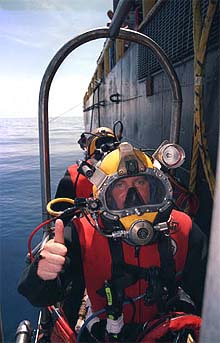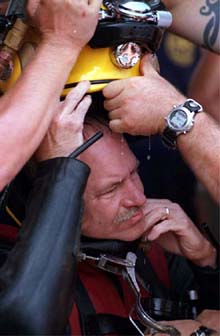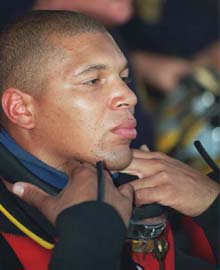
A Navy diver gives the thumbs-up sign before entering the water for a dive on the USS Monitor. Official U.S. Navy photo by Photographer’s Mate Chief Petty Officer (DV/SW) Andrew McKaskle. Click image for larger view.

Captain Chris Murray, Supervisor of Diving at Naval Sea Systems Command in Norfolk, VA, takes his MK-21 dive helmet off after completing the in-water phase of his dive. Murray now has five min to get undressed and enter the recompression chamber, where the air pressure around him will be brought to a depth of 50 ft; this is done to help him avoid decompression sickness. He will spend one hr 45 min in the chamber to allow his body to "off gas." Official U.S. Navy photo by Photographer’s Mate Second Class Petty Officer (DV) Eric Lippmann. Click image for larger view.
Engineman Petty Officer Third Class (DV) Christopher Dixon of MDSU-2, Little Creek, VA, prepares to make his first working dive since graduating from U.S. Navy Second Class Dive School. He will descend 240 ft below the ocean surface to the wreck site of the USS Monitor. Official U.S. Navy photo by Photographer’s Mate Chief Petty Officer (DV/SW) Andrew McKaskle. Click image for larger view.
Reflections on the Monitor 2001 Expedition
August 16, 2001
Commander Barbara Scholley, U.S. Navy
Commanding Officer, Mobile Diving and Salvage Unit TWO
Mobile Diving and Salvage Unit TWO ![]() (MDSU TWO) has unloaded, cleaned and restored all of its diving gear in preparation for the next operation; however, memories of the Monitor 2001 Expedition are still strong. The Navy dive team that supported this year’s operation will not quickly forget the excitement, hard work, and challenges faced during the recovery of the Monitor’s steam engine. Each and every diver performed to the highest level to make the work a huge success, and as the Commanding Officer of MDSU TWO, I can say that we had the best dive team in the Navy out there!
(MDSU TWO) has unloaded, cleaned and restored all of its diving gear in preparation for the next operation; however, memories of the Monitor 2001 Expedition are still strong. The Navy dive team that supported this year’s operation will not quickly forget the excitement, hard work, and challenges faced during the recovery of the Monitor’s steam engine. Each and every diver performed to the highest level to make the work a huge success, and as the Commanding Officer of MDSU TWO, I can say that we had the best dive team in the Navy out there!
The Monitor 2001 Expedition Navy Dive Team was comprised of 148 divers from 24 different diving commands. They included 20 diving officers, 4 diving warrant officers and 10 master divers. They ranged from senior divers with more than 25 years of experience to junior divers who had only finished dive school weeks before the operation started. The one common trait of all these divers was that they couldn’t wait to actually make a dive on the wreck of the USS Monitor. This was definitely the most exciting dive that most of these divers have made, or probably will make, in their careers. At the same time, they accomplished a job that will provide a piece of naval history for the entire country to view and reflect upon. This made the operation even more worthwhile.
As much as the divers loved the expedition, however, it was also a lot of long hours and hard work. Diving operations were conducted 24 hrs a day, 7 days a wk. Even with the unpredictable weather that historically plagues Cape Hatteras, diving operations stopped for only three days during the entire six-wk period. That added up to a tremendous amount of diving accomplished between the two different diving stations. The Mixed Gas Surface Supplied Divers made 429 dives and had 201 hrs of actual work on the wreck. This required 1139 hrs of decompression. The Saturation Divers had 465 hrs of work on the wreck and 216.8 man-days in saturation. This was all safely accomplished with no injuries to any of the divers.
Even though this year’s expedition is finished, the valuable training and experience that the Navy divers gained from the operation will stay within the Navy for years to come. It’s hard to predict, but I would speculate that the Monitor Expeditions are directly responsible for many divers making Navy diving a career, and also for training several generations of future master divers and diving officers. This has been a wonderful success, and we all eagerly await the opportunity to participate in the Monitor 2002 Expedition. Navy divers have a cheer that is completely appropriate for the Monitor 2001 Expedition: "HooYah!"
Sign up for the Ocean Explorer E-mail Update List.























